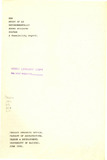| dc.description.abstract | EXECUTIVE SUMMARY:
1. It is possible to build an environmentally-appropriate
permanent structure in central Nairobi for about 10% less
cost than similar buildings being erected today. Such a
structure, relying heavily on locally available materials
and techniques which, in most cases, are less energy consuming
but are more labour-intensive in production, can
also be operated for considerably less cost than many
existing buildings, and with a higher rate of utilization.
The key factors in bringing about such prospective and··
beneficial results are: the use of construction materials
and techniques which are cheaply made locally, rather than
being imported; major attention being given to energy conservation,
both in terms of capital investment and in
programme operation; optimization of use of space and
services through a 'sharing system' which encourages
cooperation between different organizations.
2. All these factors require shifts of perception away from
current local practices if they are to be successfully
employed in new construction projects. In some cases,
changes are required in land tenure arrangements, in
building codes, in restrictive regulation in the energy
field but, probably most important of all, in the everyday
perceptions of ordinary people and the use they make of
their built environments.
What is needed to trigger such changes is the right client,
since it is the client who creates the demand for innovation
in response to difficult environmental conditions presently
being faced.
3. The Client, (Some Operating Assumptions): assume that
one of the country's major public institutions, the
University, wishes to expand its programmes and facilities
in order to serve the country better and that, while it has
land available for expansion, it has little or no money
to do so. The conventional response would he to give up
the expansion plans and wait until the economic situation
improves or a willing donor turns up with the financial
resources required. This, in today's climate, may take a
long time.
4. Very often, Universities take the position that change and
adaptation to circumstances are to be avoided and that
tradition must be maintained at all costs. Tradition
provides that University resources are for exclusive
University use with the result that sports facilities may go
unused, residences may stand empty for large portions of
the year, classrooms and lecture halls may be in use for
only a few hours a day and so forth. At the same time, there
may be a substantial demand for such facilities by others
who cannot gain access.
5. In the present exercise, the hypothetical I client' , the
University, decides that if it is to expand its facilities,
it will have to overcome traditional constraints and seek
partners in its building ventures partners who can
cooperate with the academic institution in specifying the
design and ultimate patterns of use of the new structure. | en_US |



